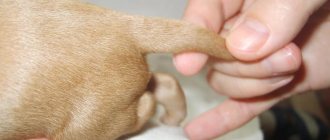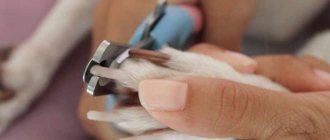Sterilization of dogs is a manifestation of the responsibility of the owner. As puppies grow up, their sexual instincts can cause many problems. One of them is unwanted offspring from a bitch that has no breeding value. If the owner’s plans do not include breeding puppies, then the only way out is to sterilize the dog. What is sterilization, when can it be carried out, what should the owner know about this procedure, what the consequences may be - we will answer these and other questions of dog owners in our article.
What is sterilization
Sterilization is a surgical operation after which a dog can no longer reproduce. The procedure is common, but requires preliminary preparation of the animal and has a recovery period. Surgery is performed under general anesthesia (narcosis).
Important!
Take a responsible approach to choosing a clinic and a doctor who will perform sterilization in order to minimize risks and undesirable consequences.
Castration of dogs, pros and cons
- The operation is more complicated than sterilization, since the animal's genitals are removed. But it has a number of advantages than sterilization:
- The behavior of the four-legged friend is changing for the better, the female is not mating, and the male is not marking his territory
- Aggression and the desire to tear everything disappear
- The dog has no sex drive
But many animal owners consider such an operation inhumane and dangerous. Of course, the recovery period is long, but why torture an animal if you don’t want to raise offspring?
Types of dog sterilization
Veterinary medicine does not stand still - today clinics offer various types and methods of sterilization of pets.
Cavity technique
The classic method of sterilization involves dissection of the abdominal cavity under general anesthesia. Veterinarians practice three methods of abdominal surgery:
- Amputation of the uterus and ovaries (ovariohysterectomy).
- Removal of the ovaries (oophorectomy). Most often it is carried out before the first heat.
- Ligation of the fallopian tubes (oviduct) without removing the ovaries and uterus. The dog loses the ability to fertilize, but can continue to mate.
The first two methods are scientifically called castration in veterinary medicine. However, the more common term is sterilization. This is the technique most often used. With this technology of surgical sterilization, the female loses her sexual instinct and the ability to fertilize.
Laparoscopic methods
The most gentle methods of sterilization, which are carried out in a hospital setting and require expensive equipment - a laparoscope (video endoscope).
- Ovariohysterectomy. A minimally invasive technology in which the uterus and ovaries of a bitch are removed without a wide dissection of the abdominal cavity.
- Ovariectomy. Amputation of the ovaries using the laparoscopic method through punctures of tissue.
- Microlaparotomy. A minimally invasive method of sterilization in which the uterus and ovaries are removed through one puncture.
These methods have many advantages:
- less blood loss;
- fast rehabilitation period;
- reducing the risk of complications.
The only downside is that this is a high-tech method that requires modern, expensive equipment and highly qualified surgeons. Such sterilization is not carried out at home.
At what age is it better to sterilize a dog?
The age of sterilization of dogs is still a subject of debate among veterinary specialists. Domestic and foreign veterinarians argue about the optimal timing of the procedure. There are several sustainable practices around the world:
- Pediatric sterilization is performed on puppies between 6 and 14 weeks of age. It is widespread among American shelters, where they try to place already sterilized puppies once they are 2 months old.
- Early sterilization. The operation is performed when female puppies reach the age of 5-6 months.
- Classical sterilization. The operation is scheduled 2-3 weeks before the first estrus. Usually this age is from six months to one and a half years. The optimal period for dogs that are not planned to be used for breeding.
- Late sterilization. Surgery on females over 6 years old. It is carried out for medical reasons or for purebred dogs that participated in breeding the breed.
Important!
The decision about the age to neuter your dog should be made together with your veterinarian, taking into account all factors: breed, size of the animal, health status.
In what cases and at what age is sterilization performed for medical reasons?
- Dogs over 8 years of age undergo surgery to prevent or minimize the risk of developing cancer.
- Bitches participating in breeding are sterilized after the last birth. It is recommended to do this at an age not exceeding 6 years.
- If a dog has a hormonal imbalance, abnormally heavy and prolonged estrus, they are operated on at any age.
- Some unscrupulous owners resort to sterilizing pregnant bitches - this is dangerous! If your dog's pregnancy turns out to be unwanted, it is best to let her give birth and have surgery a month after giving birth.
- In the early stages of pregnancy, surgery can be done as prescribed by a veterinarian if the dog’s health does not allow it to bear and give birth to puppies. In such a situation, it is important not to delay this procedure.
How to extend your pet's life
In order for the mongrel to live the maximum that nature has given her, you need to follow the rules of her maintenance:
- Regular veterinary examinations and timely vaccinations remain a necessity, regardless of the breed.
- Regular walking, during which the dog can burn off energy. This is especially important for pets living on a leash.
- Sterilization, which can be carried out both before the onset of puberty (about 6 months) and for an adult animal. The offspring of mongrels are of no value, and sterilization protects against dangerous diseases of the genital organs.
Sterilization increases the life expectancy of animals. The most important thing is the love and care of the owner. Dogs are smart enough to understand how they are treated. The feeling of uselessness provokes stress in them and shortens their lives.
I also have a dog from the street. We picked her up when she was 3-4 months old. Of course, by this time she had acquired street habits, such as a love for trash cans and an all-encompassing joy at the sight of any woman.
But otherwise, he is a very smart creature. We didn’t take her to school, she knows several commands so she can walk her safely. But he lives in a booth in the yard.
Sometimes we take him out for a walk, but we hope that there is enough space to run around in the yard - sometimes there is a column of dust (it chases the cats). Probably the only thing we did according to the rules was to get all the vaccinations and sterilize. We try to do the rest as best we can.
We consider her a member of the family, love, pet and play with her. The other day we were walking in the park and were amazed that our Bertha walked calmly on a leash and didn’t even turn an ear to the purebred dogs rushing at her with barking (from Yorkies to a beautiful German Shepherd).
[custom_ads_shortcode3]
Pros and cons of the operation
There is no consensus in society. Dog owners are divided into two opposing camps. Some people don’t like the uncontrolled reproduction and growth of the dog population. The latter do not allow the thought that their pet will be deprived of the joy of motherhood. Which camp to join is up to you. We will talk about the advantages that sterilization provides and the disadvantages - possible risks and complications.
pros:
- the most effective measure for regulating the number of offspring;
- a way to combat the number of homeless stray dogs;
- method of controlling unwanted pregnancy;
- radical contraception for dogs that are prohibited from pregnancy or childbirth for health reasons;
- a dog without sexual instincts becomes more attached to a person and is better trained;
- the owner may not be afraid of attacks from male dogs when walking his female dog;
- dogs become calmer and more peaceful;
- a reliable method of preventing sexually transmitted diseases;
- the risk of oncological pathologies (pyometra, ovarian cyst, uterine cancer) is reduced;
- spayed females live longer on average by 1.5-2 years.
Minuses:
- risk of developing postoperative complications;
- an unpredictable reaction of the animal to anesthesia is possible;
- there is a risk of gaining excess weight after surgery;
- Neutered dogs often have urinary incontinence.
Important!
To minimize possible risks, choose a clinic and veterinarian who will perform the operation responsibly. Insufficient qualifications, lack of experience or necessary equipment can lead to dire consequences.
Video - the pros and cons of sterilization
Is it possible to do without surgery?
People often come to veterinarians with this question. Doctors answer - it’s possible. But they immediately ask counter questions - are you ready to take full responsibility for your pet? Will you be able to completely control your bitch during her heat? Can you cope with the possible destructive behavior of the bitch during this period? Are you sure that you will not allow unwanted mating? Can you guarantee that refusal to sterilize will not lead to the development of malignant neoplasms in a dog?
If you are confident that you can handle all this, then you don’t have to sterilize your dog. If you plan to cope with sexual desire with the help of medications, remember that long-term use of pills is detrimental to your pet’s health . Weigh the pros and cons, talk to your veterinarian, and decide what's best for your dog. Leave everything as is or operate and forget about all these problems.
Video - to sterilize or not
https://www.youtube.com/watch?v=Fopz6yNlpfM
Castration of a male dog
The features of male surgery become clear when considering its advantages and disadvantages, as well as the optimal timing. Knowing these nuances, you can easily weigh the pros and cons before deciding on the procedure.
Positive and negative points
Male dogs are operated on to suppress their excessive activity and increased attraction to the opposite sex. The advantages of this event include:
- eliminating attacks from other dogs (due to low testosterone, the pet is no longer perceived as a competitor);
- normalization of urination;
- eliminating the risk of infection during accidental mating;
- reduction in outbreaks of aggression towards other dogs;
- preventing new marks in the house and attempts to escape to the next four-legged chosen one;
- improvement of working qualities due to increased concentration on hunting, service or dog sled racing;
- reducing the risk of developing many pathologies (oncology, diseases of the cardiovascular system, prostate and thyroid glands).
Among the disadvantages are rapid weight gain. Without tracking daily physical activity and caloric intake, a neutered pet may become obese.
The number of positive moments outweighs the number of negative ones. The only significant disadvantage can be easily prevented with the help of proper care.
Optimal age
The optimal age for castration of dogs occurs shortly after their puberty, that is, at 7-12 months. There is no upper limit, since in more mature and old age animals are castrated for medical reasons. In such cases, operational risks are less than possible deviations.
Up to a year, surgical intervention is easier, since the testes are still small and easier to use with a scalpel. The remaining stitch heals quickly and practically does not bother the pet.
If your pet is a small breed and suffers from persistence (residual teeth), then it is safer to perform 2 operations at once - remove the testicles and excess teeth. In this case, the amount of anesthesia will be half as much.
Medical indications and contraindications
Another argument in favor of surgical intervention is the high likelihood of pathology associated with the activity of the testes. If you leave your dog with his genitals, then as he ages he risks encountering the following problems:
- oncology (seminoma, sertolioma, leydigoma);
- perineal hernia;
- prostatitis;
- cryptorchidism.
Individuals younger than 5 months or older than 6 years are operated on only for medical reasons. It is also not recommended to castrate weakened and sick animals suffering from diseases of the cardiovascular system and kidneys, as well as within a month after vaccination. Before the procedure, the veterinarian conducts a full diagnosis to exclude possible hidden pathologies.
Intervention methods
There are 4 methods of surgical intervention that deprive a dog of reproductive function. These include:
- Surgical
. Most often used. It is carried out in an open or closed way. In the second case, the surgeon removes the testis without opening the vaginal box.
- Chemical
. It is used to temporarily relieve sexual desire as opposed to steroid drugs. After six months, reproductive function returns. Suitable for working animals planning to have offspring in the future.
- Vasectomy
. It is limited to ligation of the seminal ducts while maintaining sexual desire.
- Scrototomy
. Involves additional removal of the scrotum due to the high likelihood of edema due to age or the presence of dermatitis and testicular neoplasia.
Before choosing a method, be sure to discuss all the details with your veterinarian. If you do not plan to breed the breed, then it is safer to go with the first option.
Possible complications
The likelihood of negative consequences is minimal. Most complications occur in the postoperative period due to the fault of the owners. During this period, try to follow all medical recommendations and immediately seek help if:
- disturbances in heart rhythm;
- changes in the shade of mucous membranes and weakening of the pulse;
- unpleasant-smelling discharge intensely oozing from the seam;
- local temperature in the area of the seam or its divergence;
- frequent nausea;
- wheezing and convulsions.
Remember that if the condition of the operated animal does not stabilize within a week, then it needs to be shown to a doctor. The described complications are rare, so with proper care you will not encounter them.
All surgical risks are associated with bleeding disorders and anesthesia. Make sure your veterinarian checks to make sure there is no von Willebrand disease or other breed conditions that could cause severe blood loss when tissue is excised.
With anesthesia everything is more complicated. The result will be known only after the dog’s first life of the procedure. If the animal does not tolerate anesthesia very well, be sure to remember this and enter the information in the veterinary passport.
Surgery for cryptorchid
Cryptorchidism is the location of the testicles outside the scrotum. The danger of this congenital anomaly is the constant overheating of the gonads, leading to the development of a malignant tumor. In cryptorchids, oncology occurs after 5 years, although in normal conditions it does not bother the animal until the age of 10.
The pathology is difficult to track without diagnosis if the testicles are in the abdominal area. In such cases, metastasis can only be detected with regular visits to the veterinary clinic. Although doctors advise not to risk it and to castrate the animal immediately after puberty.
How to prepare a dog for sterilization
Both abdominal surgery and laparoscopy are performed under general anesthesia. Therefore, special attention is paid to preparing the pet for surgery.
Preparation for surgery:
- examining the veterinarian's medical history - be prepared to show the animal's medical record;
- a comprehensive examination of the dog’s health in a veterinary clinic - only absolutely healthy animals are allowed to operate;
- preliminary diagnostic studies: tests (stool, urine, blood), echocardiography, abdominal x-ray, ECG, etc. Conducted for medical reasons;
- studying the vaccination card - puppies and dogs without vaccinations are not sterilized. Vaccination is carried out no later than 3-4 weeks before the expected date of surgery. This point applies to primary vaccination and revaccination if more than 12 months have passed since the last vaccination;
- mandatory treatment of the animal with anthelmintic and anti-flea drugs 3 weeks before surgery;
- anti-stress measures - the doctor may prescribe sedatives 3-4 days before the procedure;
- strict starvation diet - the bitch is stopped feeding 12 hours before surgery;
- water regime - access to water is stopped 5-7 hours before sterilization;
- selection of the type and dosage of anesthesia, taking into account medical indications and the weight of the animal.
Important!
Refuse the services of veterinary clinics that offer to sterilize your dog without preparation - do not risk the health and life of your pet!
Preparing for surgery
You need to stop feeding your dog at least 6-8 hours beforehand. Water must be abandoned 4 hours in advance. Before the operation, the animal must be examined to eliminate possible risks associated with anesthesia. It is also advisable to first do an ultrasound of the reproductive organs and take blood tests (biochemical, general).
How is abdominal surgery performed?
After all preparatory measures have been completed, the day of the operation is set. The first thing doctors in the clinic must do is carry out the premedication stage. The dog is given medications that will help the animal endure anesthesia - without this stage there is a risk of serious complications.
The dog is placed on a sterile surface and immobilized. Then the animal is given anesthesia using the chosen method. Sterilization of dogs is always carried out under general anesthesia. The choice of the type of anesthesia is carried out at the stage of preparation for the operation by the surgeon, the dosage is calculated by the anesthesiologist before the procedure.
One of three types of anesthesia can be given:
- Intravenous. Safe and effective way.
- Intramuscular. A common budget method.
- Inhalation. It is carried out only in a clinical setting, dear.
When the dog loses sensitivity, the surgeon shaves off the fur at the incision site on the abdomen and disinfects it. The abdominal cavity is cut with a sterile scalpel and the doctor excises the uterus and ovaries, ovaries or ligates the fallopian tubes. It all depends on which sterilization method is chosen.
After this, internal and external sutures are applied with self-absorbing threads, and the surgical area is dried with sterile swabs and treated with antiseptics. On average, the operation takes from 30 to 90 minutes.
Laparoscopy is a more gentle alternative to abdominal surgery. Currently, this procedure is being used more often. Read more about the distinctive features and advantages of the high-tech method below.
Canine laparoscopy
The most important difference between laparoscopy and abdominal surgery is that the area of intervention in the dog’s body is minimized. The procedure is performed under general anesthesia in clinics that have special high-tech equipment - a laparoscope.
A laparoscope (videoendoscope) is an optical device that consists of a thin tube with a lens and a video camera unit. The enlarged image from the lens is transmitted to the monitor - the veterinarian can see the animal’s internal organs.
How is laparoscopy performed?
The surgeon makes one (microlaparotomy) or two punctures (incisions) on the abdomen of the anesthetized dog. The size of the cuts is 5-10 mm. A special gas is injected through these punctures to improve visibility and a laparoscope is inserted.
Using surgical instruments located at the ends of the tubes, the doctor removes the reproductive organs. The amputated uterus and ovaries are removed through punctures. Finally, a self-absorbing suture is applied to the incision area.
Benefits of laparoscopy
- Only an endoscope is inserted into the dog's abdominal cavity - this guarantees that the surgeon will not forget anything inside.
- There is no need to prepare your dog for surgery for a long time; it is enough not to give it food 2-3 hours before the procedure.
- Reduced operation time – laparoscopy lasts approximately 15 minutes. This reduces the risk of complications.
- No postoperative care or medication is required.
- Reduced risk of bleeding and infection during surgery.
- Fast recovery after surgery - food can be given 2 hours after sterilization.
- There is no postoperative stress.
- The procedure is less painful and easier for animals to tolerate.
- The puncture site is treated with surgical glue (seamless technology) or self-absorbable threads. Seam processing is minimal (1-2 times) or not required at all.
In what cases is laparoscopy not performed?
- The dog's weight is more than 15 kg.
- The animal has a history of heart disease, bleeding disorders, and lung pathologies.
- The bitch's pregnancy is late.
How to avoid negative consequences
- Remember that laparoscopic sterilization cannot be cheaper than the cavity method. Do not agree to offers from clinics that captivate you with their cheapness .
- Avoid laparoscopic sterilization at home. This may not be safe at home .
- Choose the method and method of sterilization that your doctor knows best. Check the surgeon’s qualification level and inquire about his experience. Talk to dog owners who have already had surgery with this specialist.
- Be sure to undergo preoperative preparation and examination of your pet . Do not sign an agreement with clinics that do not offer preparatory measures.
Care after sterilization surgery
In most cases, dogs recover quickly from surgery. But, in some difficult cases, the doctor may suggest leaving the animal in the hospital under the supervision of veterinarians for a day.
What should a dog owner do in the postoperative period?
The owner of the operated bitch must help her endure the postoperative period. To help your dog recover faster, you need to take care of the following:
- Take care in advance of a clean cotton bedding, which should be placed in a secluded, warm place on the floor. During the first hours after anesthesia, the dog’s coordination of movements will be impaired; do not place it on a sofa or chair.
- It is advisable that in the first days the dog be under someone's constant supervision.
- Water is offered to the dog a little at a time 1-2 hours after the anesthesia wears off. It is best to wet her lips and nose with water.
- The animal is fed only on the second day after surgery. At first, they give wet food or soft crushed food (minced meat).
- After abdominal surgery, the sutures are treated with antiseptics for 2 weeks.
- If the animal shows interest in the wound, it is given an Elizabethan collar and blanket.
- For the first 14 days, the dog is not allowed to run, jump, or walk for a long time.
- You cannot bathe the animal until the postoperative wound has completely healed..
- During the entire recovery period, quarantine measures must be observed and the pet must not be allowed to come into contact with other animals.
- If your dog becomes lethargic, has a fever, decreased appetite, redness or discharge from the stitches, you should immediately contact your veterinarian .
- A sterilized dog's diet should be modified and portions reduced to reduce the risk of obesity.
Factors influencing life expectancy
Pedigree is not the primary influence on a dog's life expectancy. There are a number of factors that determine how long a particular dog can live:
- Dimensions of the animal. There is a general relationship - the larger the dog, the shorter its life expectancy. This is explained by the fact that a large weight creates a large load on the body; dogs of gigantic size more often suffer from diseases of the heart, joints and digestive tract. In addition, it is more difficult for a large dog to find enough food on the street.
- Genetic diseases. The presence of congenital pathologies in a particular individual directly affects its life. But it is worth noting that hereditary pathologies are less common in mongrels than in purebred dogs - in the process of natural selection, animals with defective genes are eliminated, which gives mongrel dogs good health.
- Food quality. Eating spoiled food, leftovers from human meals, or long periods of fasting - all this greatly shortens the life of any animal . But a complete diet that provides the mongrel with everything it needs will be a significant contribution to its longevity.
- Conditions of detention. Any mongrel dog that lives in the house with its owner and is regularly walked will live no less than a purebred dog, and due to good health, probably longer. If the dog is kept outside, then it should have a warm and dry kennel in case of bad weather, as well as the opportunity to run around the area for at least several hours a day. The best option is when the dog is kept on a chain during the day and released at night to guard the territory.
The dog should have a good kennel in the yard and the opportunity to periodically be without a chain
[custom_ads_shortcode1]
Dog behavior after sterilization
The method of sterilization affects how the dog will behave after surgery.
After laparoscopy
Animals recover quickly after minimally invasive surgery methods. The first hours after laparoscopy, the pet is under the residual effect of anesthesia. The bitch may be lethargic, walk swaying, and experience apathy.
As soon as the anesthesia wears off, the dog will behave as if no operation had ever taken place. It is allowed to give food and water 2 hours after surgery.
After abdominal surgery
Abdominal surgery takes longer, the animal is under anesthesia longer, the area of injury is larger and the pain syndrome is higher. All this affects the behavior of the animal after sterilization.
The dog may sleep for several hours after surgery due to general anesthesia. It is best to leave her in the clinic until she fully awakens. After the operated bitch wakes up she will be shivering - put her in a warm place.
In the first hours after waking up, the animal will have poor coordination and weakness. It is important to be close to your pet to protect him from accidental bumps and falls.
The doctor should warn about possible pain syndrome, prescribe painkillers, and advise on how and when to use them. It is necessary to strictly observe the recommended dosage and follow all recommendations.
Advantages and disadvantages of the procedure
The benefits of castration include:
- No unwanted puppies;
- Prevention of a number of diseases (including cancer);
- Lack of uncontrollable hormonal surges;
- Calmer, flexible behavior;
- Decreased sexual desire;
- Protection against inflammatory processes and sexually transmitted infections;
- The dog becomes more owner-oriented;
- There is no tendency to escape;
- According to statistics, castrated animals live longer.
Destructive behavior associated with sexual desire is easier to correct in castrated animals. Sometimes, in the absence of major sex hormones, inappropriate behavior goes away without correction.
The main disadvantage of castration is the need for anesthesia . Dogs have a much harder time recovering from anesthesia than humans. And before performing an operation, a veterinarian’s consultation is necessary for each individual case. For some animals (especially older and obese animals), the castration procedure may be contraindicated.
It is believed that castrated animals are more susceptible to bone cancer and hypothyroidism due to an imbalance of thyroid hormones. This information has no scientific basis; both castrated and natural dogs suffer from cancer or hypothyroidism.
Consequences and complications
No surgical intervention on the body can guarantee the complete absence of complications and undesirable consequences. Complications can arise due to a surgeon’s error or lack of qualifications, due to the dog’s individual reaction to anesthesia, or due to non-compliance with the rules for caring for the dog after surgery.
Complications can arise with both classical cavity sterilization and laparoscopy. The laparoscopic method minimizes risks if the procedure is performed by an experienced doctor using high-quality equipment.
Complications in the postoperative period
- Vomit. It often happens as a reaction to anesthesia. One-time - goes away on its own. It is important not to leave your dog alone to prevent it from choking. If it is uncontrollable, call the veterinarian.
- Hyperthermia (increased body temperature). This is a normal condition in the first hours after surgery. If the dog is lethargic, does not eat or drink, and has a fever that lasts longer than 2 days, call a veterinarian.
- Internal bleeding. A very serious complication. It is indicated by lethargy, compaction and redness in the area of the postoperative suture, pale (white) mucous membranes of the oral cavity. A doctor must examine the dog immediately!
- Infected wound. The suture site may be swollen for the first 2-3 days. If after this period the wound is swollen, bleeding, or pus is released from it, call a veterinarian.
Long-term consequences
- Estrus. Yes, this happens if the surgeon performed an operation with violations and completely removed the reproductive organs. To fix this, you will have to operate on the dog again.
- Obesity. The use of anesthesia and changes in hormonal levels slow down the dog’s metabolism. It is important to choose the right diet and portion size, as well as provide your pet with sufficient physical activity. Your veterinarian will tell you what to feed a spayed female dog.
Important!
Monitor your pet carefully so that if any warning signs appear, contact your veterinarian promptly.
Postoperative period
The four-legged patient is returned to the owner immediately after he regains consciousness. To prevent the seam from licking, a protective collar is put on it and taken home.
Care and recovery
The speed of recovery depends not only on the individual characteristics of the pet, but also on your care for it. To normalize the condition of the operated animal you will need:
- Find a comfortable place, protected from drafts. Place the bed on a horizontal surface and wrap your pet in a blanket.
- Buy a set of absorbent diapers. The anesthesia will wear off for some time, so the place of sleep and toilet will coincide. Simply put, the dog can go crazy, and more than once.
- Check your breathing and pulse rates regularly.
- Prevent walking into other rooms. Due to lack of coordination, the dog may hit.
- Every half hour, moisturize the mucous membranes with water.
- Avoid swimming and active walks.
- Prevent damage to healing wounds.
- Stimulate bowel function with Vaseline or a laxative if there is no bowel movement for more than 2 days. In this case, an enema is prohibited.
Suture treatment is carried out as directed by the doctor. In most cases, the threads dissolve on their own and no additional care is required.
Catering
Feeding begins after the anesthesia wears off. Before this time, the animal may choke or develop aspiration pneumonia due to food particles or liquid entering the lungs. The fasting diet can last up to 3 days.
In the first week of rehabilitation, solid food is replaced with liquid food. The animal is fed wet canned food or broths with puree.
Cost of dog sterilization
The cost of the operation depends on the level of the clinic, the qualifications of the staff, the quality and quantity of materials used before, during and after the operation. You need to take this into account so as not to give your dog into the hands of unscrupulous surgeons. For a low price, you can pay dearly with the health and even life of your dog.
Next, we will indicate the average price tag for classical and laparoscopic sterilization.
Cavitary
The cost of the operation depends on the weight of the dog. The larger the dog, the more expensive the procedure will be.
Russia
- Moscow and St. Petersburg - from 2,500 to 9,000 rubles.
- Regions of Russia – from 3,900 to 12,000 rubles.
Ukraine
- Kyiv – from 900 to 1,700 UAH.
- Regions of Ukraine – from 1000 to 2500 UAH.
Laparoscopic (endoscopic)
Russia
- Moscow and St. Petersburg - from 7,500 to 16,000 rubles.
- Regions of Russia – from 6,000 to 14,000 rubles.
Ukraine
- Kyiv – from 2,400 to 3,500 UAH.
- Regions of Ukraine – 2,600 to 4,000 UAH.
Sterilization operation at home
Many clinics offer home visits by a veterinarian. Let's look at the advantages and disadvantages of this type of service.
Advantages of sterilization at home:
- There is no need to transport the animal. There is no possible stress during transportation.
- The dog falls asleep in a familiar home environment and wakes up there. She is not unnerved by other people's sounds or smells. The recovery period is easier and faster.
- No contact with other dogs is guaranteed. In the clinic such contact is possible.
- The doctor devotes all his time to your pet and is not distracted by other visitors.
- There is time to chat with the surgeon, ask questions and get answers.
- You are with your dog the entire time.
Minuses:
- It is not possible to create completely sterile conditions.
- It is difficult to create the conditions necessary for the operation and find a suitable place.
- Only abdominal surgeries are performed at home.
- There is no equipment for resuscitation. If something goes wrong, the doctor will have to transport the animal to the clinic.
What you will need for surgery at home:
- A clean room with good light, preferably a bathroom washed with disinfectants.
- Operation table. It also needs to be washed and treated with disinfectants.
- Medical oilcloth.
- A place where the surgeon can place his instruments.
Cost of home surgery
The cost of surgery at home depends on the territorial distance from the clinic. The price for such a procedure is usually higher than for a similar one in a hospital.
Russia
- Moscow and St. Petersburg - from 3,000 to 11,000 rubles.
- Regions of Russia – from 4,000 to 8,000 rubles.
Ukraine
- Kyiv – from 950 to 1,800 UAH.
- Regions of Ukraine – from 1,000 to 2,800 UAH.
How many years have they lived at home?
Some mongrels are lucky and live in an apartment or private house as full-fledged members of the family. They are given regular walks, bought expensive balanced food and taken to the veterinarian for a preventive examination. With this care, on average, a dog can live about 15 years, or even longer.
Over time, the yard dog becomes everyone's family favorite. Animals are easy to learn and intuitively feel the owner. Indoors, they quickly remember their place, the main thing is that it is away from heaters and noisy household appliances.
Mongrel dogs are affectionate and sociable and get along well with children. Small pets can live to a very respectable canine age - 18-20 years. Larger individuals live 5 years less.
[custom_ads_shortcode2]
FAQ
Is it possible to take a dog home immediately after sterilization surgery?
In most cases, if the surgery went well, the veterinarian will discharge the dog home after sterilization. Pets are only allowed at the clinic if there are medical indications. Some veterinary institutions offer a paid service for hospital placement after surgery. If you are worried about your pet, you can take advantage of this opportunity.
How to transport a sterilized dog? I have a shepherd. I'm afraid that I won't be able to carry her in my arms to the car.
If, according to indications, the doctor says to leave the dog in the clinic for a day, then the dog will already have time to recover from the anesthesia and it will walk to the car on its own. The main thing is to lay an oilcloth or absorbent diaper on the car seat. If the dog will not be left at the clinic, take an assistant, preferably a strong man.
Three months have passed since the operation. Our Chihuahua girl is in heat. Is it possible?
What you call heat is most likely just bloody discharge from the dog's welt. Be sure to show her to the vet! These discharges may be symptoms of diseases: inflammation of the uterine stump, tumor or hormonal imbalance.
We adopted an adult dog from a shelter. We don't know her exact age, the vet says 6 or 7 years old. Is it possible to be sterilized at this age?
It is possible to operate at an older age, but only after a full examination, passing all tests and consulting a cardiologist.
At the clinic they offer us to perform the operation using some special method, not by cutting the dog, but by puncturing it. Isn't this dangerous?
It is not clear which method is offered at the clinic. Most likely - microlaparotomy. This is a minimally invasive sterilization method. It is low-traumatic, with less anesthesia, and without the need for postoperative care. There are many advantages to such sterilization. Minus - the operation is not recommended for animals weighing more than 10-15 kg.
Tell me what to do if a dog has a lump on its stomach after sterilization? Had surgery a week ago. The lump is small, dense, similar in size to a surgical suture.
Call the vet! Let him examine the dog. Most likely, this is a lump that you call a lump, a granulation suture. And the dog has a reaction to the threads used to make it. This often happens exactly 5-7 days after surgery. This condition goes away in 2-3 weeks.
We operated on a shepherd dog at the age of 4 years. Three months later, the dog began to develop brownish discharge from the loop. Is it possible for a dog to have inflammation of the uterine stump after sterilization? Or is it some kind of hormonal imbalance?
Inflammation of the uterine stump occurs in rare cases in operated dogs. Therefore, you must definitely show the animal to a veterinarian. Only he will be able to establish a diagnosis and prescribe competent treatment if necessary.
What should you do if, after sterilization, your dog starts peeing at home?
One of the possible complications of the operation is urinary incontinence. More common in large breed dogs. Caused by changes in the hormonal levels of the animal. The bitch must be taken to a veterinarian for diagnosis and treatment. Usually, hormonal drugs and agents that increase the tone of the urinary tract and bladder (Propalin) are used. In some cases, surgical intervention is resorted to.
We have two dogs of different sexes. Will they mate if the girl is sterilized and the boy is not?
It all depends on how the dog is sterilized. If she just had her tubes tied, it will be. When the uterus and ovaries are removed, the mating instinct may persist only for the first time after the operation, until the dog forgets what it is.
When can you take your dog outside after surgery?
If everything is fine with the dog, it has recovered from anesthesia, there are no complications, then you can walk it on the day of the operation. Walks should be short, without contact with other dogs in the first 10 days after sterilization.
I'm interested to know how a dog's character changes after sterilization? I'm afraid that the dog will become cowardly or aggressive.
Your fears are in vain. The dog’s character does not change after the operation, so it will not become more cowardly. But the level of aggression may decrease and the animal will become calmer.
Factors influencing life expectancy
Pedigree is not the primary influence on a dog's life expectancy. There are a number of factors that determine how long a particular dog can live:
- Dimensions of the animal. There is a general relationship - the larger the dog, the shorter its life expectancy. This is explained by the fact that a large weight creates a large load on the body; dogs of gigantic size more often suffer from diseases of the heart, joints and digestive tract. In addition, it is more difficult for a large dog to find enough food on the street.
- Genetic diseases. The presence of congenital pathologies in a particular individual directly affects its life. But it is worth noting that hereditary pathologies are less common in mongrels than in purebred dogs - in the process of natural selection, animals with defective genes are eliminated, which gives mongrel dogs good health.
- Food quality. Eating spoiled food, leftovers from human meals, or long periods of fasting - all this greatly shortens the life of any animal . But a complete diet that provides the mongrel with everything it needs will be a significant contribution to its longevity.
- Conditions of detention.
Any mongrel dog that lives in the house with its owner and is regularly walked will live no less than a purebred dog, and due to good health, probably longer. If the dog is kept outside, then it should have a warm and dry kennel in case of bad weather, as well as the opportunity to run around the area for at least several hours a day. The best option is when the dog is kept on a chain during the day and released at night to guard the territory. The dog should have a good kennel in the yard and be able to periodically be without a chain.
[custom_ads_shortcode2]
Owner reviews
Dmitry : “We sterilized our dog at the age of 4 years. The doctor who performed the operation on us said that this would help prevent cancer of the uterus and ovaries. The dog gave birth once before. The operation was performed using the usual abdominal method. In our city they do not perform laparoscopy. Everything went well. The dog walked around in a blanket for two weeks, and we treated its stitches. After the operation the dog became calmer. But there was one drawback; it would be dishonest if I didn’t tell you about it. Our girl developed slight incontinence. No, she doesn't pee all the time. She produces spontaneous drops of urine. This happens most often in the cold season.”
Natalya Petrovna : “I was afraid to sterilize my dog. Therefore, I spent a long time choosing a clinic, calling and consulting with veterinarians, asking how much the procedure cost. I found out from the dog owners how the operation was performed on them. As a result, I decided to have a microlaparotomy. This operation costs more, but I was promised minimal trauma and a complete absence of complications. Everything went very quickly, no rehabilitation was required. The dog recovered from the anesthesia and I took it home. They operated on her in the morning, and in the evening she was already asking to go outside and wanted to run. I even had to restrain her.”











